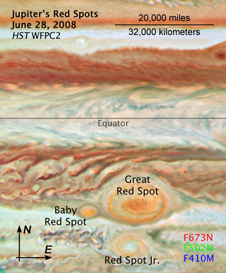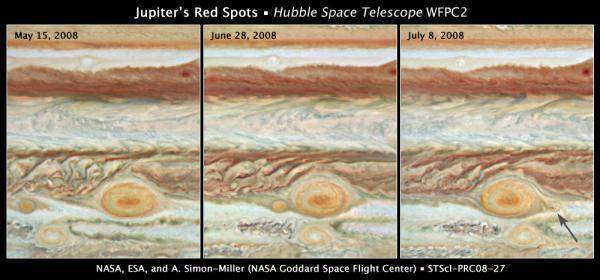The largest storms in the solar system, known as Jupiter's Great Spots, are merging

Spectacular photographs from the Hubble Space Telescope reveal unprecedented phenomena in the atmosphere of the largest planet in the solar system. The young red spot Passing through the big red spot.
The young red spot was created in early 2006 when a white storm strengthened and turned red, this in contrast to the great red spot that has been raging for hundreds of years. This is the second time the young spot has passed by its big brother, but so far no merger of three storms has been observed.
The researchers created an image that demonstrates the movement of the three spots on May 15, June 28 and July 8, 2008. All images were taken in original colors by Hubble's planetary camera and combined into one image to illustrate the sequence of events.
According to the image it can be seen that the young red spot comes from the west, crosses through its older brother from the south and exits to the east of it. Amateur astronomers confirmed NASA's observations and reported that the young spot had come out deformed and had lost its red color.

According to the predictions, the Great Red Spot will attract the young spot and swallow it forever. This process is not unusual, it is a natural process that has been happening for at least 150 years.
The Great Spot has been studied since 1830 even though it was discovered hundreds of years ago. The Hubble Space Telescope, operated by the American Space Agency and the European Space Agency, has made a significant contribution to the study of the spots and from time to time it reveals new discoveries about the complex atmosphere of Jupiter.

3 תגובות
Not interesting
The title says that the red spots united, and in the text it is written that the young spot united with the big one and came out the other side, and that in a short time it will be drawn back to the big spot and disappear forever.
Very interesting, but the title does not at all match what the text says.